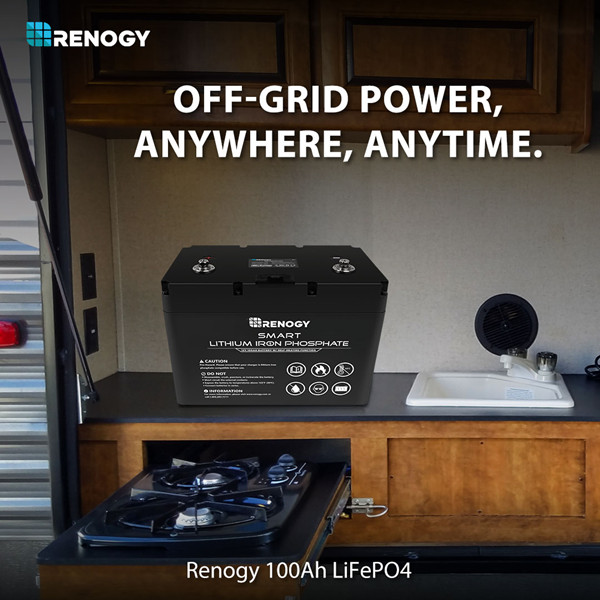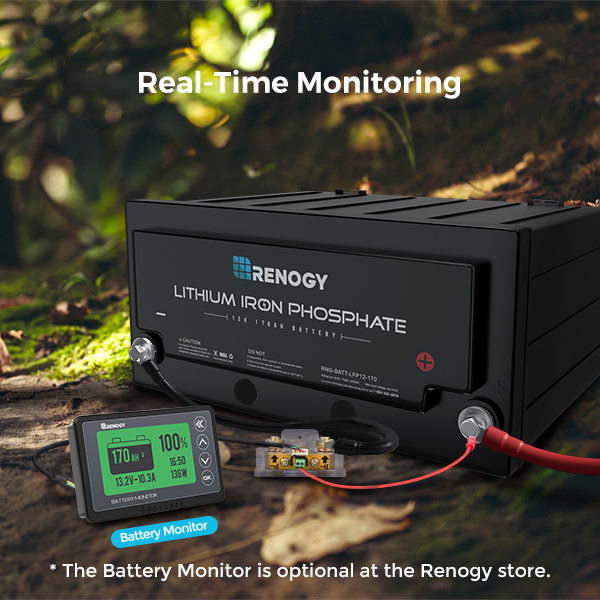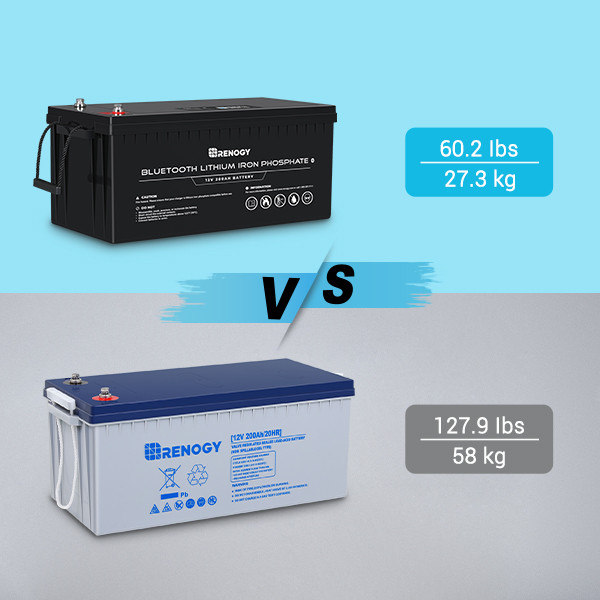How to Tell if a Deep Cycle Battery is Bad
Deep cycle batteries are everywhere, forming the backbone for many household and recreational electrical systems and products. They can be found in everything from golf carts and RVs to the cell phones in our pockets.
The term "deep cycle" comes from the fact that the batteries are designed to be drained of most of their charge repeatedly without damaging the cells within the battery. A typical battery, like the lead-acid one under the hood of your car, can't handle this power cycling and will degrade fast.
Even though deep cycle batteries for solar are advancing fast and becoming more durable and long lasting all the time, eventually, like anything, they start to give out.
But how do you know when your deep cycle battery is going (or maybe has already gone) bad?
We're going to cover that and a few other things involving deep-cycle batteries including:
So read on to learn about deep-cycle batteries and general maintenance tips.
How to Tell if a Deep Cycle Battery is Bad
It won’t charge
This might seem like a freebie, but if your deep-cycle battery won't charge, it's probably bad.

You will want to test your battery charger on another battery to ensure it's not the charger's fault before assuming that the expensive bundle of technology in front of you is the culprit. Borrow a friend's charger to try on your battery as an additional test to ensure something isn't weird with your charger.
It isn’t maintaining a charge
If your deep cycle battery that used to last for a long time is suddenly getting hot to the touch or seems to be draining far too quickly, it’s time to get it tested or replaced.
A hot battery under normal conditions means something isn't right inside the circuitry or actual chemical reactions within the battery. Not paying attention to this could lead to a fire.
Under normal use, it’s normal for batteries to be warm. It's when they pass that threshold that it’s dangerous.
Sluggish performance
Suppose your deep cycle battery is experiencing sluggish performance, i.e., taking extra long to charge or not seeming to handle the power requirements that it used to. In that case, it could be a sign that the battery is going bad.
What Ruins a Deep Cycle Battery?
Deep cycle batteries are designed to be regularly discharged "deeply," meaning using most of their capacity. As such, they are a great storage source for renewable energy. However, certain things can ruin a deep-cycle battery if not correctly taken care of.

Overcharging
One of the more common causes of damage to deep-cycle batteries that we come across regularly is overcharging. Overcharging can occur when the battery is left plugged in for too long or charged at too high a voltage. This causes the electrolyte solution inside the battery to become too hot, which can lead to permanent damage. It's essential to use a charger specifically designed for deep-cycle batteries and to follow the manufacturer's instructions carefully when charging them.
Sulfation
Sulfation occurs when the battery has been sitting idle for an extended period without being used or recharged. Sulfation causes crystals to form on the plates inside the battery, reducing its ability to hold a charge and eventually leading to failure. To prevent sulfation from occurring, it's important to recharge your deep cycle battery every few months, even if you're not using it regularly.
Discharging too often
Another common way deep-cycle batteries can be damaged is by discharging them too deeply or too frequently. That might seem odd since deep cycle batteries are, after all, meant to be discharged deeply. However, they are still batteries and can be damaged if discharged below around 50% of their capacity.
Discharging deep-cycle batteries too frequently can also damage their lifespan and performance. Deep cycle batteries are designed to be regularly discharged using most of their capacity, but if drained too quickly and without proper recharging or rest, the electrolyte solution inside the battery can become too hot, leading to permanent damage.
Any deeper than 50% reduces their lifespan and could lead to permanent damage. A few batteries available have an 80% safe discharge rate. Still, they tend to be significantly more expensive and harder to find.
Taking proper care of your deep cycle battery will ensure that it lasts as long as possible and continues providing reliable power for years to come.
What output voltage means a deep cycle battery is considered dead
You can easily perform a voltage test on a deep-cycle battery you suspect is bad using any voltage meter (voltmeter) that tests for DC. A fully charged, 12-volt deep cycle battery typically has a voltage range between 12.8V and 13V, while a bad battery's voltage is below 10 volts. If your battery has been on the charger for quite a while and isn't rising to the expected voltage, it is likely at the end of its life.
In order to properly maintain your deep cycle battery and ensure long life expectancy, it's important to regularly monitor its voltage levels. If you detect that the battery's voltage has dropped too low, it means that it needs to be recharged or replaced.
Also, if you find your deep cycle battery charging abnormally fast or slow, in that case, it could indicate an issue with your system or charger, which must be addressed promptly in order to avoid any further damage to the battery.
There is also a thing called "false voltage," where you test the voltage at the battery terminals, and everything seems fine. The moment you put any load on the battery, it fails.
This is generally caused by defective cells within the battery. When the battery is cool, the contacts touch, allowing proper conductivity. When a load is placed on the battery, these points heat up and pull apart, breaking the bond necessary to transfer power.
When Should I Replace My Deep Cycle Battery?
While the average lifespan of a deep cycle battery is about 3-6 years, the exact length of its life span can vary significantly depending on several factors, such as the type of battery, how it is used and maintained, and the climate in which it is kept. Charger type and frequency of charge/discharge (as mentioned above) are also determining factors.
Because of these factors, it can be challenging to determine precisely when to replace your deep-cycle battery. However, following the indicators listed above should give you a solid idea.
How to Troubleshoot Deep Cycle Battery Issues
Troubleshooting a battery issue follows a process of elimination. It is important to start by addressing the most general and simple things first, such as checking for any possible signs of loose or dirty terminals and connections. Suppose there is an excessive amount of corrosion or heat marks visible. In that case, it may be necessary to carry out some general maintenance on the terminals before continuing with further troubleshooting steps.

It's also essential to check the age of your battery so that you know whether it has reached its end of life. If you have had your battery for several years, then this could be a major factor in any performance issues that you are experiencing, and you should consider replacing the battery as soon as possible.
Once any general problems have been addressed, other steps may include checking the voltage at the terminals using a voltage meter and testing your charger to ensure it functions correctly. Additionally, if the issue persists, more precise methods such as multimeter tests or diagnostic scans can be used for further investigations until the source of the problem has been identified and rectified.
Quick Tips to Prolong Your Battery’s Life
●Ensure your charger is compatible with your battery type. Make sure you use the correct voltage and amperage settings on that charger, too. Trying to charge a 12V battery with a multi-volt charger set at 24V is not good for the battery.
●Never fully discharge your battery! Worst case scenario, you one-and-done your battery by completely discharging it and can never get it to take a charge again.
●Match your battery to the environment you're putting it in. If you will be in extremely hot, wet, or cold environments, make sure you choose a battery that is designed to handle it. If you constantly have to replace batteries, this could be one of your problems.
●Check the state of charge on your battery. Maintaining the charge helps prevent sulfation which seriously degrades the cell life.
We Have It
At Renogy, we understand that your battery is critical to powering all of your devices. That's why we specialize in providing the highest quality deep cycle batteries, inverters, chargers, and charge controllers on the market.
Our products are designed and manufactured with a focus on durability and performance that you can trust. We also offer impressive features such as anti-corrosion technology on weather-exposed parts and other safety measures for maximum reliability. So if you're looking for a reliable power source, there's no better place to turn than Renogy. We also have solar power generators for sale. Check out our range of first-class products today!
Related articles:
Should I Disconnect My RV Battery When Plugged In?
How To Charge A Lithium Battery?
Solar Battery Storage System Cost: Things You Need To Know
Battery Dies In Cold Weather: What Low Temperatures Do To Your Battery








